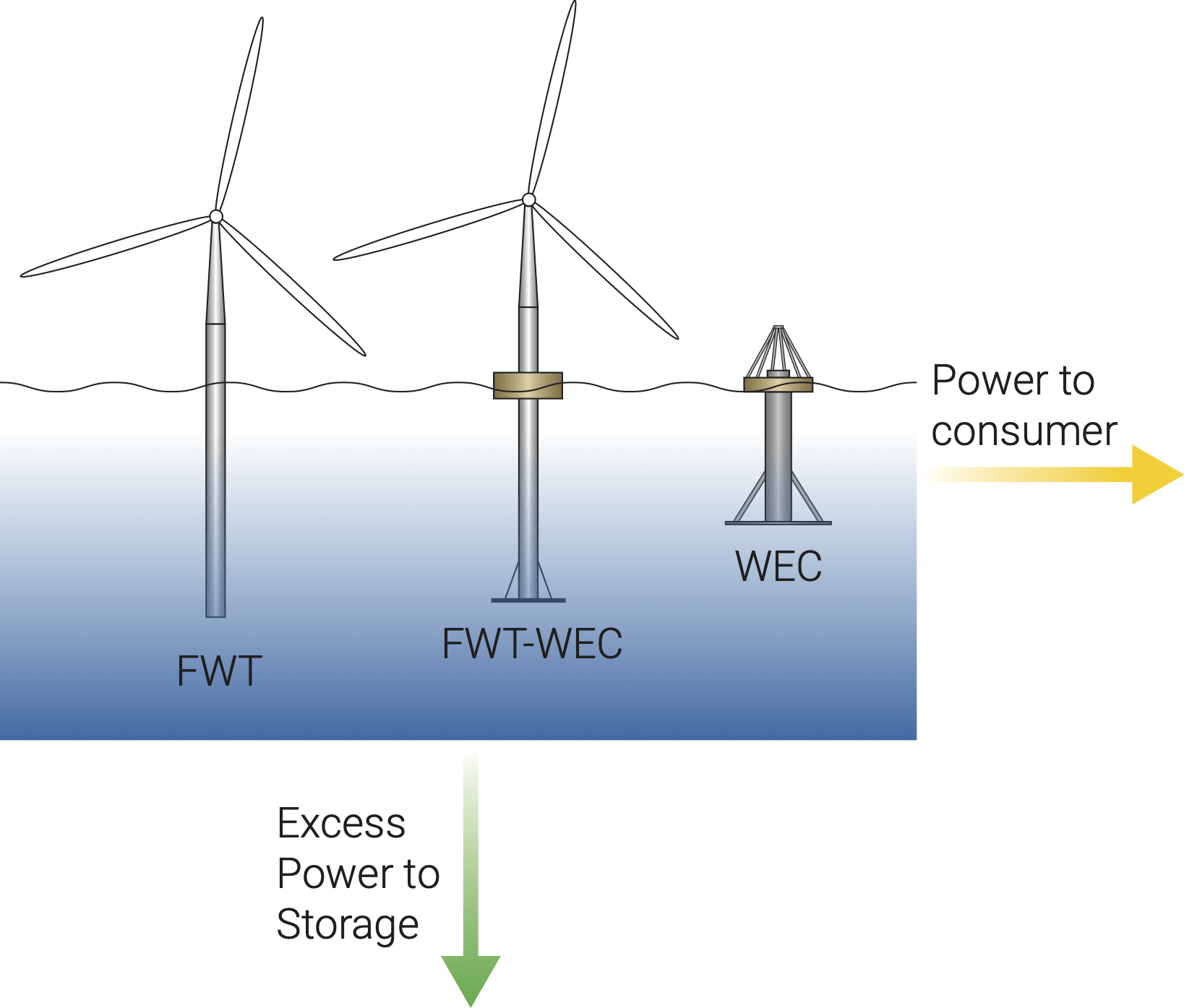Offshore Energy
In the SEA Lab, we are studying ways to harness and store energy from the ocean. We design and analyze systems ranging from wave energy converters and offshore wind turbines for energy generation to offshore hydrogen production for energy storage.
Wave Energy
Wave energy converters (WECs) remain expensive due to challenges of how to robustly convert the time- varying stochastic waves to high-quality electricity, supports frames that comprise up to 50% the device mass, and low storm survivability. Research in the SEA Lab focuses on how to maximize economic benefit of WECs by considering coupling them with other marine structures, such as offshore wind turbines, using them to generate electricity for smaller scale systems, such as offshore aquaculture farms and autonomous underwater vehicle docking stations, or leveraging the high pressure water generated by WECs for more efficient seawater desalination processes. Our group also investigates how wave energy can be incorporated into a mix of renewably energy assets as a means to provide grid-stability.

Relevant Publications:
- J. M. Kluger, M. N. Haji (co-first author), and A. H. Slocum, “The mechanical and supply-demand power balancing benefits of wave energy converters in combined offshore wind-wave and energy storage farms,” Applied Energy, 331, 120389, 2023. https://doi.org/10.1016/j.apenergy.2022.120389
- Y. Q. Ang, A. Polly, A. Kulkarni, G. Bahl Chambi, M. Hernandez, and M. N. Haji, “Multi-objective optimization of hybrid renewable energy systems for a prototypical coastal community,” Renewable Energy, 201 (1), 72-84, 2022. https://doi.org/10.1016/j.renene.2022.09.126
- R. McCabe, O. Murphy, and M. N. Haji, “Multidisciplinary Optimization to Reduce Cost and Power Variation of a Wave Energy Converter,” International Design Engineering Technical Conferences & Computers and Information in Engineering Conference, St. Louis, MO, August 14-17, 2022. https://doi.org/10.1115/DETC2022-90227
- M. N. Haji, J. M. Kluger (co-first author), T. P. Sapsis, and A. H. Slocum, “A Symbiotic Approach to the Design of Offshore Wind Turbines with Other Energy Harvesting Systems,” Ocean Engineering, 169, 673-681, 2018. https://doi.org/10.1016/j.oceaneng.2018.07.026
Hydrogen Production and Storage
The U.S. has announced a commitment to catalyze the deployment of offshore wind at scale, however the increased grid penetration of offshore wind energy requires the ability to deal with the variability of the wind energy output. One potential method of smoothing these variations is through the use of offshore wind energy to produce hydrogen at sea that can then be stored for later use in fuel cells. In the SEA Lab, we research the viability, and economic opportunities, of combining offshore wind with hydrogen production, via electrolysis. Our group also investigates how production of hydrogen can be paired with passive mineral extraction to simultaneously harvest minerals such as lithium and cobalt from the oceans.
Offshore Energy
In the SEA Lab, we are studying ways to harness and store energy from the ocean. We design and analyze systems ranging from wave energy converters and offshore wind turbines for energy generation to offshore hydrogen production for energy storage.
Wave Energy
Wave energy converters (WECs) remain expensive due to challenges of how to robustly convert the time- varying stochastic waves to high-quality electricity, supports frames that comprise up to 50% the device mass, and low storm survivability. Research in the SEA Lab focuses on how to maximize economic benefit of WECs by considering coupling them with other marine structures, such as offshore wind turbines, using them to generate electricity for smaller scale systems, such as offshore aquaculture farms and autonomous underwater vehicle docking stations, or leveraging the high pressure water generated by WECs for more efficient seawater desalination processes. Our group also investigates how wave energy can be incorporated into a mix of renewably energy assets as a means to provide grid-stability.

Relevant Publications:
- J. M. Kluger, M. N. Haji (co-first author), and A. H. Slocum, “The mechanical and supply-demand power balancing benefits of wave energy converters in combined offshore wind-wave and energy storage farms,” Applied Energy, 331, 120389, 2023. https://doi.org/10.1016/j.apenergy.2022.120389
- Y. Q. Ang, A. Polly, A. Kulkarni, G. Bahl Chambi, M. Hernandez, and M. N. Haji, “Multi-objective optimization of hybrid renewable energy systems for a prototypical coastal community,” Renewable Energy, 201 (1), 72-84, 2022. https://doi.org/10.1016/j.renene.2022.09.126
- R. McCabe, O. Murphy, and M. N. Haji, “Multidisciplinary Optimization to Reduce Cost and Power Variation of a Wave Energy Converter,” International Design Engineering Technical Conferences & Computers and Information in Engineering Conference, St. Louis, MO, August 14-17, 2022. https://doi.org/10.1115/DETC2022-90227
- M. N. Haji, J. M. Kluger (co-first author), T. P. Sapsis, and A. H. Slocum, “A Symbiotic Approach to the Design of Offshore Wind Turbines with Other Energy Harvesting Systems,” Ocean Engineering, 169, 673-681, 2018. https://doi.org/10.1016/j.oceaneng.2018.07.026
Hydrogen Production and Storage
The U.S. has announced a commitment to catalyze the deployment of offshore wind at scale, however the increased grid penetration of offshore wind energy requires the ability to deal with the variability of the wind energy output. One potential method of smoothing these variations is through the use of offshore wind energy to produce hydrogen at sea that can then be stored for later use in fuel cells. In the SEA Lab, we research the viability, and economic opportunities, of combining offshore wind with hydrogen production, via electrolysis. Our group also investigates how production of hydrogen can be paired with passive mineral extraction to simultaneously harvest minerals such as lithium and cobalt from the oceans.
